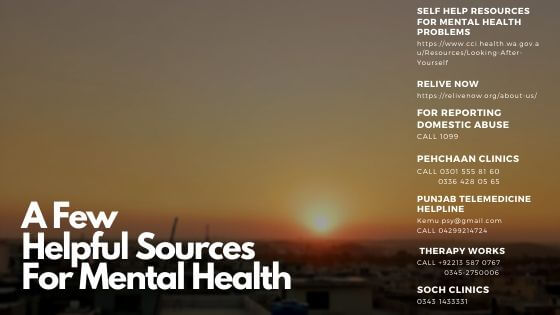The anxiety of COVID-19 shall not outlive our resolve

By Alishba Naeem
The occurrence of a pandemic is unforeseeable. While living through this point in time, it may seem that the changes our lives will undergo are equally unforeseeable. As COVID-19 continues to spread around the globe, governments are adopting standard social distancing measures to contain the virus. Though absolutely necessary, quarantine is unusual for human life. Historical evidence from previous pandemics such as Russian influenza (1889), Spanish flu (1918) and SARS (2003) depicts that pandemics leave a psychological impact on the population. Therefore, psychologists have been raising awareness regarding mental health issues that people might face.
Before heading onto how we can adapt to these circumstances lets understand the dynamics of social distancing in local context. Fear and uncertainty are two emotions predominantly associated with pandemics. As a lot of young people generally live with their families, they may be worried about older members of the family contracting the virus. Rising number of cases and casualties leads to a sense of helplessness and anxiety. Also, many people living in the same house for extended periods of time without a break strains family relations. Women and children are more exposed and vulnerable to domestic abuse in current scenario. Needless to say, there is uncertainty with respect to economic wellbeing of people; from daily wagers to salaried individuals. In any case, the striking issue at hand is of the level of acceptance in society of mental health issues and how much we show solidarity to someone who has been going through these.
While the situation may not be in our control, our behaviors and responses can help us steer through these difficult times. The World Health Organization (WHO) has published a comprehensive guideline on mental wellbeing categorized by people belonging to different groups.1 Some of the broad range of adaptive and coping strategies in addition to the WHO recommendations are discussed as following:
Keeping healthy relations among family members
Our society has undergone several changes over the years with young people looking outwards for affection and solidarity more often than at home. A lot of young people have expressed on social media that being unable to identify with home is causing an adverse impact on their mental wellbeing in these times. This calls for understanding of others’ fears, what triggers them and mechanism to minimize and manage them.
Some general advices for everyone
The British Association for Counseling and Psychotherapy 2 has put forward a list of things which can help avoid distress. This includes keeping a routine, breathing exercises, expressing worries, accessing sunlight and fresh air and maintaining connection with friends and family though virtual means.
Expressing your fears through writing, art or talking
Psychologists suggest this as means to finding relief from thoughts which bother us. Also, it is important that experiences of varying sections of people are voiced and known. The people with access to internet are able to voice them in public and find support online but those who do not have access may have less options.
Managing time spent on digital or conventional media sources
This is important not just because there is a lot of misinformation out there but because there is bombardment of information in today’s digital and news media. Moreover, subjecting oneself to distressful information repeatedly is inviting existential dread. This is definitely a no go.
For people with underlying psychological condition
It is recommended that those suffering or have a history of anxiety, depression or any other psychological health condition stay connected with their therapist to minimize chance of relapse or aggravation of current condition. Keeping a routine, meditating and trying something new is helpful in keeping a healthy mindset.
For governments and healthcare providers
Government authorities can adopt measures such as i) providing a common portal for accessing online mental health services whether private or government; ii) extending financial or in-kind support to those in need; iii) coordinated response and dissemination of information regarding COVID-19 and related issues to avoid confusion; iv) revisiting their choice of words in discussions and announcements related to COVID-19 to avoid panic and misunderstanding
It is easy to hail healthcare providers as our heroes, but their physical and emotional wellbeing also need to be taken care of. Provision of personal protective equipment (PPE), management of duty shifts to allow for appropriate breaks and rest time, outlets to express and manage work related stress to minimize cases of post-traumatic stress disorder should be ensured 3 to help them in performing their duties effectively.
Role of the community
Those who can afford should contribute to charity, relief efforts whether in form of in-kind, money donations or time in volunteering for relief efforts. Helping old, sick neighbors with grocery, other essential errands, can be a source of mental peace. For any community work, it is advisable to consider such contributions only if you have learnt the safe and protective ways to take care of yourself and others during this pandemic.
“Love recognizes no barriers. It jumps hurdles, leaps fences, penetrates walls to arrive at its destination full of hope.” Maya Angelou
——————-
Alishba Naeem is an aspiring researcher and writer with a focus on sociological and political problems. She is an MPhil student of Public Policy at PIDE.
1 WHO guidelines Mental health and psychosocial considerations during the COVID-19 outbreak. March 18th, 2020 https://www.who.int/docs/default-source/coronaviruse/mental-health-considerations.pdf
2 https://www.facebook.com/TheBACP/videos/334860864138934/
3 Managing mental health challenges faced by healthcare workers during Covid-19 pandemic March 20th, 2020 https://www.bmj.com/content/368/bmj.m1211



